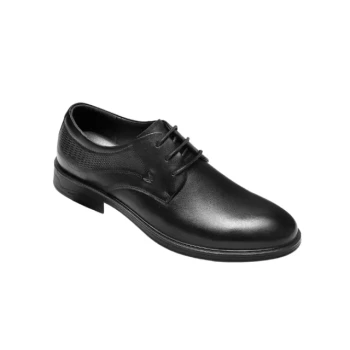The Oxford shoe earned its name directly from its place of early popularity: Oxford University. Around the 1820s, students there began wearing a new style of low-cut shoe as a comfortable and rebellious alternative to the restrictive, high-heeled boots that were standard formalwear at the time.
The modern Oxford shoe is a direct descendant of a boot called the "Oxonian." This boot, popular among Oxford University students, was gradually redesigned with a lower heel and its now-iconic closed lacing system, cementing both its name and its place in formalwear history.
The Origin Story: From University Boot to Formal Staple
The "Oxonian" Boot
The direct predecessor to the Oxford was a half-boot known as the Oxonian. This was a snug-fitting ankle boot, notably lower than the prevailing fashion.
A Student-Led Shift
Initially, the Oxonian boot featured slits on its side for a more comfortable fit. Students at Oxford University embraced this style as a welcome break from the tall, formal boots required of them.
The Evolution to a Modern Shoe
Over time, the side-slit design evolved. The fastening moved from the side to the instep, creating the lacing system we see today. The boot's shaft was cut down entirely, and the heel was lowered, transforming the Oxonian boot into the sleek, low-cut Oxford shoe.
What Truly Defines an Oxford Shoe?
The Closed Lacing System
The single most critical characteristic of an Oxford is its closed lacing system. This means the quarters—the leather panels containing the lace eyelets—are sewn underneath the vamp, which is the front section of the shoe.
A Sleek, Formal Silhouette
This construction method creates a clean, uninterrupted profile and a slim silhouette. The lacing panels are drawn together tightly, resulting in a snug fit that makes the Oxford the quintessential dress shoe for formal and business attire.
Understanding the Nuances in its Heritage
The Role of Scotland and Ireland
While the name is inextricably linked to the university, some historical accounts place the shoe's earliest origins in 19th-century Scotland and Ireland. It is likely that similar low-cut shoe styles were developing concurrently in different regions.
The University's Enduring Legacy
Regardless of its exact geographical birthplace, the students of Oxford University are credited with popularizing the style and driving its evolution. Their adoption of the shoe is what gave it its famous name and launched its journey into mainstream fashion.
Applying This to Your Wardrobe
The Oxford's history as a formal, refined shoe directly informs its use today.
- If your primary focus is formal or business attire: A classic leather Oxford, especially in black or dark brown, is the definitive choice to pair with a suit.
- If your primary focus is elevated smart-casual: Consider an Oxford in a different material like suede or a lighter color, which slightly softens its formality.
The Oxford’s evolution from a comfortable campus boot to a global symbol of elegance is a testament to its timeless design.
Summary Table:
| Key Feature | Description |
|---|---|
| Name Origin | Popularized by students at Oxford University in the 1820s. |
| Predecessor | Evolved from the 'Oxonian' ankle boot. |
| Defining Trait | Closed lacing system for a sleek, formal silhouette. |
| Modern Use | The quintessential dress shoe for business and formal attire. |
Elevate Your Footwear Collection with Timeless Quality
As a large-scale manufacturer, 3515 produces a comprehensive range of footwear for distributors, brand owners, and bulk clients. Our production capabilities encompass all types of shoes and boots, including classic Oxfords built with the same attention to detail and enduring style that defines their history.
Partner with us to offer your customers superior craftsmanship and timeless designs.
Contact our team today to discuss your manufacturing needs and how we can bring value to your brand.
Related Products
- Custom Manufactured Air Cushion Leather Business Shoes for Wholesale
- Wholesale Comfortable Business Casual Shoes Custom Manufacturing
- Wholesale Perforated Comfort Dress Shoes | Custom Derby Shoe Manufacturer
- Wholesale Leather Derby Shoes Manufacturer | Customizable Business & Dress Footwear
- Wholesale Training Shoes with Dial Lacing System Custom OEM Manufacturing
People Also Ask
- What are the key features of high-quality leather in shoes? Invest in Durability and a Perfect Fit
- How does leather compare to other shoe materials in terms of durability and comfort? A Material Guide for Footwear
- What are the characteristics of business casual sneakers? Master the Polished & Professional Look
- Why are sneakers now accepted in office environments? The Shift to Modern Professionalism
- Can trainers/sneakers be worn in a business casual setting? How to Choose the Right Style for a Professional Look



















